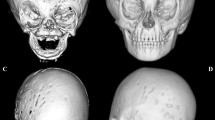Abstract
Background
Non-syndromic coronal synostoses oxycephaly and brachycephaly (NSCSOB) are rare. Their natural history, surgical management, and outcome are debated.
Material and methods
We reviewed the available literature on NSCSOB. In addition, we reviewed retrospectively our experience with cases of NSCSOB, managed and operated by our joint craniofacial team since 1984. Newborns underwent perifrontal craniectomy, while infants and older children underwent fronto-orbital advancement with frontoparietal remodeling. Cases with delayed onset of faciosynostosis were excluded.
Results
Some cases of NSCSOB present at birth or even prenatally with gross dysmorphism and severe brachycephaly; others present later in life with harmonious restriction of intracranial volume and are at risk for development and vision. Some NSCSOB evolve from initially unisutural synostoses. We treated 61 cases, operated aged 1.4 to 106.7 months, 30 with brachycephaly and 31 with oxycephaly. Twelve of these (19.7 %), had been treated initially for sagittal or unicoronal synostosis, and evolved into NSCSOB. Intracranial hypertension was present initially in 28 (45.9 %), with ophthalmological consequences in 13 (21.3 %) and mental retardation in 6 (9.6 %). No patient had hydrocephalus; only two had asymptomatic Chiari malformation. The mean postoperative follow-up was 113.6 months. At last control, 21 patients had developmental delay and 5 had visual impairment.
Conclusions
NSCSOB are a complex entity. They have in common a high risk of severe intracranial hypertension and rare hydrodynamic complications. Genetic screening is necessary to assert their non-syndromic nature. Prolonged follow-up of all craniosynostoses is necessary because unisutural synostoses can evolve into NSCSOB, and NSCSOB can evolve into craniofaciosynostosis.









Similar content being viewed by others
References
Bou-Salah A, Galli I, Ouahes A, Azzal S (1984) Craniosténoses en Algérie. Indications opératoires et résultats d’une technique personnelle. [Craniostenosis in Algeria. Surgical indications and results of a personal technique]. Neurochirurgie 30:417–421
Cinalli G, Sainte-Rose C, Kollar EM, Zerah M, Brunelle F, Chumas P, Arnaud E, Marchac D, Pierre-Kahn A, Renier D (1998) Hydrocephalus and craniosynostosis. J Neurosurg 88:209–214
Cinalli G, Spennato P, Sainte-Rose C, Arnaud E, Aliberti F, Brunelle F, Cianciulli E, Renier D (2005) Chiari malformation in craniosynostosis. Childs Nerv Syst 21:889–901
Coeugniet E, Dhellemmes P, Vinchon M, Wolber A, Pellerin P (2012) Midfacial distraction without osteotomy using a transfacial pin and external devices. J Craniofac Surg 23:184–189
Connolly JP, Gruss J, Seto ML, Whelan MF, Ellenbogen R, Weiss A, Buchman SR, Cunningham ML (2004) Progressive postnatal craniosynostosis and increased intracranial pressure. Plast Reconstr Surg 113:1313–1323
Greene CS (1998) Pancraniosynostosis after surgery for single sutural craniosynostosis. Pediatr Neurosurg 29:127–132
Jimenez DF, Barone CM (2010) Multiple-suture nonsyndromic craniosynostosis: early and effective management using endoscopic techniques. J Neurosurg Pediatr 5:223–231
Kim SW, Shim KW, Plesnila N, Kim YO, Choi JU, Kim DS (2006) Distraction vs remodeling surgery for craniosynostosis. Childs Nerv Syst 23:201–206
Lo LJ, Marsh JL, Yoon J, Vannier MW (1996) Stability of fronto-orbital advancement in nonsyndromic bilateral coronal synostosis: a quantitative three-dimensional computed tomographic study. Plast Reconstr Surg 98:393–409
Marchac D, Renier D, Arnaud E (2008) Unoperated craniosynostosis patients: correction in adulthood. Plast Reconstr Surg 122:1827–1838
Nelhaus G (1968) Head circumference from birth to eighteen years. Practical composite international and interracial graphs. Pediatrics 41:106–114
Pellerin P, Dhellemmes P, Lepoutre F, Ribière J (1987) Traitement Chirurgical des brachycéphalies. [Surgical treatment of brachycephaly]. Ann Chir Plast Esthet 32:307–317
Reddy K, Hoffman H, Armstrong D (1990) Delayed and progressive multiple suture craniosynostosis. Neurosurgery 26:442–448
Reinhart E, Mühling J, Michel C, Collmann H, Pistner H, Reuther J (1996) Craniofacial growth characteristics after bilateral fronto-orbital advancement in children with premature craniosynostosis. Childs Nerv Syst 12:690–694
Renier D, Cinalli G, Lajeunie E, Arnaud E, Marchac D (1997) L’oxycéphalie, une craniosténose sévère. À propos d’une série de 129 cas. [Oxycephaly: a severe craniosynostosis. Analysis of 129 cases]. Arch Pediatr 4:722–729
Renier D, El Ghouzi V, Bonaventure J, le Merrer M, Lajeunie E (2000) Fibroblast growth factor receptor 3 mutation in nonsyndromic coronal synostosis: clinical spectrum, prevalence, and surgical outcome. J Neurosurg 92:631–636
Schouman T, Vinchon M, Ruhin-Coupet B, Pellerin P, Dhellemmes P (2008) Isolated bilateral coronal synostosis: early treatment by peri-fronto-orbital craniectomy. J Craniofac Surg 19:40–44
Vinchon M, Pellerin P, Pertuzon B, Fénart R, Dhellemmes P (2007) Vestibular orientation for craniofacial surgery: application to the management of unicoronal synostosis. Childs Nerv Syst 23:1403–1409
Whitaker LA, Bartlett SP, Schut L, Bruce D (1987) Craniosynostosis: an analysis of the timing, treatment, and complications in 164 consecutive patients. Plast Reconstr Surg 80:195–212
White N, Evans M, Dover MS, Noons P, Solanki G, Nishikawa H (2009) Posterior calvarial vault expansion using distraction osteogenesis. Childs Nerv Syst 25:231–236
Author information
Authors and Affiliations
Corresponding author
Rights and permissions
About this article
Cite this article
Vinchon, M., Pellerin, P., Baroncini, M. et al. Non-syndromic oxycephaly and brachycephaly: a review. Childs Nerv Syst 28, 1439–1446 (2012). https://doi.org/10.1007/s00381-012-1800-2
Received:
Accepted:
Published:
Issue Date:
DOI: https://doi.org/10.1007/s00381-012-1800-2




